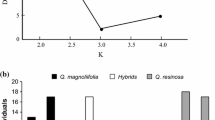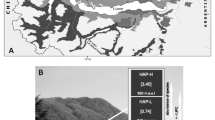Abstract
Introgressive hybridisation between Senecio hercynicus and Senecio ovatus (Compositae, Senecioneae) was studied in a mixed stand of the two species on the S- and SW-facing slopes of the German part of the Bohemian Forest (SE Germany). Morphological variation based on multivariate analysis of 14 diagnostic characters, along with genetic data from an amplified fragment length polymorphism (AFLP) fingerprinting analysis, indicates that the surveyed stand forms an intensively introgressed hybrid swarm. The majority of individuals were found to be intermediate between the two parental taxa, and strong statistical correlation between phenetic and genetic distances was observed. In contrast to that, flowering time of individuals (expressed as the time when 50% of the capitula of a plant were in flower) was found to follow a bimodal distribution in the hybrid swarm and lacked any correlation with the genetic and morphological relationships among plants. The same was true for the spectra of pyrrolizidine alkaloids (PA) revealed by a gas-chromatographic survey: most of the 142 individuals surveyed fell into one of two main chemotypes, only a few plants exhibited an intermediate and additive PA spectrum, and no correlation with the genetic and morphological relationships among plants was observed. Assuming that most of the AFLP markers are neutral, we conclude that the correlation of morphology with the genetic pattern may argue for the neutrality of morphological features analysed. Consequently, we interpret the lack of correlation between phenological and phytochemical data with the neutral genetic markers as evidence that both phenology and phytochemistry may be either under selection or that these features are genetically or biosynthetically constrained.






Similar content being viewed by others
References
Aldridge G, Campbell DR (2009) Genetic and morphological patterns show variation in frequency of hybrids between Ipomopsis (Polemoniaceae) zones of sympatry. Heredity 102:257–265
Anderson E (1948) Hybridization of the habitat. Evolution 2:1–9
Anderson E (1949) Introgressive hybridization. Wiley, New York
Antonovics J (2006) Evolution in closely adjacent plant populations: long-term persistence of prereproductive isolation at a mine boundary. Heredity 97:33–37
Arnold ML (1997) Natural hybridization and evolution. Oxford University Press, Oxford
Barton N, Hewitt G (1985) Analysis of hybrid zones. Annu Rev Ecol Syst 16:113–148
Buerkle CA, Lexer C (2008) Admixture as the basis for genetic mapping. Trends Ecol Evol 23:686–694
Campbell D (2004) Natural selection in Ipomopsis hybrid zones: implications for ecological speciation. New Phytol 161:83–90
Campbell D, Waser N (2001) Genotype-by-environment interaction and the fitness of plant hybrids in the wild. Evolution 55:669–676
Cheeke PR (1988) Toxicity and metabolism of pyrrolizidine alkaloids. J Anim Sci 66:2343–2350
Clausen J, Keck DD, Hiesey WM (1940) Experimental studies on the nature of species. I. Effect of varied environments on western North America plants. Carnegie Institute of Washington, Washington, DC: Publ. 520
Cleland EE, Chuine I, Menzel A, Mooney HA, Schwartz MD (2007) Shifting plant phenology in response to global change. Trends Ecol Evol 22:357–365
Coyne JA, Orr HA (2004) Speciation. Sinauer, Sunderland
Czesak ME, Knee MJ, Gale RG, Bodach SD, Fritz RS (2004) Genetic architecture of resistance to aphids and mites in a willow hybrid system. Heredity 93:619–626
De Boer NJ (1999) Pyrrolizidine alkaloid distribution in Senecio jacobaea minimizes losses to generalist feeding. Entomol Exp Appl 91:169–173
Dierschke H (1995) Phänologische und symphänologiche Artengruppen von Blütenpflanzen in Mitteleuropa. Tuexenia 15:523–560
Elzinga JA, Atlan A, Biere A, Gigord L, Weis AE, Bernasconi G (2007) Time after time: flowering phenology and biotic interactions. Trends Ecol Evol 22:432–439
Endler J (1977) Geographic variation, speciation, and clines. Princeton Univ Press, Princeton
Falush D, Stephens M, Pritchard JK (2007) Inference of population structure using multilocus genotype data: dominant markers and null alleles. Mol Ecol Notes 7:574–578
Franks SJ, Sim S, Weis AE (2007) Rapid evolution of flowering time by an annual plant in response to a climate fluctuation. Proc Natl Acad Sci USA 104:1278–1284
Fritz RS (1999) Resistance of hybrid plants to herbivores: genes, environment, or both? Ecology 80:382–391
Fritz RS, McDonough SE, Rhoads AG (1997) Effects of plant hybridization on herbivore–parasitoid interactions. Oecologia 110:360–367
Fritz RS, Moulia C, Newcombe G (1999) Resistance of hybrid plants and animals to herbivores, pathogens, and parasites. Annu Rev Ecol Syst 30:565–591
Grabherr G, Gottfried M, Pauli H (1994) Climate effects on mountain plants. Nature 369:448
Grant V (1971) Plant speciation. Columbia University Press, New York
Graumann S, Gottsberger G (1988) Reproductive strategies in allogamous and autogamous Senecio species. Lagascalia 15(Extra):673–679
Hagen J (2003) Genetisch und modifikativ bedingte Variabilität der Pyrrolizidinalkaloide in Senecio jacobea L. Thesis, Technische Universität Braunschweig
Hartmann T, Toppel G (1987) Senecionine N-oxide, the primary product of pyrrolizidine alkaloid biosynthesis in root cultures of Senecio vulgaris. Phytochemistry 26:1639–1643
Herborg J (1987) Die Variabilität und Sippenabgrenzung in der Senecio nemorensis-Gruppe (Compositae) im europäischen Teilareal. Diss Bot 107:1–262
Herrera CM, Bazaga P (2008) Population-genomic approach reveals adaptive floral divergence in discrete populations of hawk moth-pollinated violet. Mol Ecol 17:5378–5390
Hochwender CG, Fritz RS, Orians CM (2000) Using hybrid systems to explore the evolution of tolerance to damage. Evol Ecol 14:509–521
Hodálová I (1996) Sympatric populations of Senecio ovatus subsp. ovatus, S. germanicus subsp. germanicus (Compositae) and their hybrid in the Carpathians and the adjacent part of Pannonia. I. Multivariate morphometric study. Flora 191:283–290
Hodálová I (1999) Multivariate analysis of the Senecio nemorensis group (Compositae) in the Carpathians with a new species from the east Carpathians. Folia Geobot 34:321–335
Hodálová I (2002) A new hybrid Senecio × slovacus from the S. nemorensis group (Compositae) in the West Carpathians. Biologia 57:75–82
Hol WHG, van Veen JA (2002) Pyrrolizidine alkaloids from Senecio jacobaea affect fungal growth. J Chem Ecol 28:1763–1772
Jiggins CD, Mallet J (2000) Bimodal hybrid zones and speciation. Trends Ecol Evol 15:250–255
Kirk H, Máčel M, Klinkhamer GL, Vrieling K (2004) Natural hybridisation between Senecio jacobaea and Senecio aquaticus: molecular and chemical evidence. Mol Ecol 13:2267–2274
Konechnaja G (1979) De generis Senecio L. specibus partis europaeae URSS. 1. Sectio Pseudo-oliganthi Sof. Novosti Sistematiki Vysshikh Rastenii 15:216–219
Kovach WL (1999) MVSP: a multivariate statistical package for windows, version 3.1. Kovach Computing Services, Pentraeth
Lenoir J, Gégout JC, Marquet PA, de Ruffray P, Brisse H (2008) A significant upward shift in plant species optimum elevation during the 20th century. Science 320:1768–1771
Lotsy JP (1925) Species or Linneon. Genetica 7:487–506
Lotsy JP (1931) On the species of the taxonomist in its relation to evolution. Genetica 13:1–16
Macel M, Klinkhamer PGL, Vrieling K, van der Meijden E (2002) Diversity of pyrrolizidine alkaloids in Senecio species does not affect the specialist herbivore Tyria jacobaeae. Oecologia 133:541–550
Mantel N (1967) The detection of disease clustering and a generalized regression approach. Cancer Res 27:209–220
McCune B, Mefford MJ (1999) Multivariate analysis of ecological data, version 4.10. MjM Software, Gleneden Beach
McNeilly T, Antonovic J (1968) Evolution in closely adjacent plant populations. IV. Barriers to gene flow. Heredity 23:205–218
Meister J, Hubaishan MA, Kilian N, Oberprieler C (2006) Temporal and spatial diversification of the shrub Justicia areysiana Deflers (Acanthaceae) endemic to the monsoon affected coastal mountains of the southern Arabian Peninsula. Plant Syst Evol 262:153–171
Meister J, Kilian N, Oberprieler C (2008) Genetic structure of Euclea schimperi (Ebenaceae) populations in monsoonal fog oases of the Southern Arabian Peninsula. Nord J Bot 25:217–226
Mitchell-Olds T, Schmitt J (2006) Genetic mechanisms and evolutionary significance of natural variation in Arabidopsis. Nature 441:947–952
Moccia MD, Widmer A, Cozzolino S (2007) The strength of reproductive isolation in two hybridizing food-deceptive orchid species. Mol Ecol 16:2855–2866
Oberprieler C (1989) Numerisch-taxonomische Studien in bayerischen Populationen der Senecio nemorensis-Gruppe (Compositae). Thesis, Ludwig-Maximilians-University, Munich
Oberprieler C (1994) Die Senecio nemorensis-Gruppe (Compositae, Senecioneae) in Bayern. Berichte der Bayerischen Botanischen Gesellschaft 64:7–54
Oberprieler C, Meister J, Schneider C, Kilian N (2009) Genetic structure of Anogeissus dhofarica (Combretaceae) populations endemic to the monsoonal fog oases of the southern Arabian Peninsula. Biol J Linn Soc 97:40–51
Orians CM (2000) The effects of hybridization in plants on secondary chemistry: implications for the ecology and evolution of plant–herbivore interactions. Am J Bot 87:1749–1756
Orr HA (2005) The genetic theory of adaptation: a brief history. Nat Rev Genet 6:119–127
Parmesan C (2006) Ecological and evolutionary responses to recent climate change. Annu Rev Ecol Evol Syst 37:637–669
Peakall R, Smouse PE (2006) GenAlEx V6: genetic analysis in excel. Population genetic software for teaching and research. Mol Ecol Notes 6:288–295
Pelser BP, de Vos H, Theuring C, Beuerle T, Vrieling K, Hartmann T (2005) Frequent gain and loss of pyrrolizidine alkaloids in the evolution of Senecio section Jacobaea (Asteraceae). Phytochemistry 66:1285–1295
Pelser BP, Veldkamp J-F, van der Meijden R (2006) New combinations in Jacobaea Mill. (Asteraceae, Senecioneae). Compos Newsl 44:1–11
Pritchard JK, Stephens M, Donnelly PJ (2000) Inference of population structure using multilocus genotype data. Genetics 155:945–959
Quinn JA, Wetherington JD (2002) Genetic variability and phenotypic plasticity in flowering phenology in populations of two grasses. J Torrey Bot Soc 129:96–106
Raudnitschka D, Hensen I, Oberprieler C (2007) Introgressive hybridisation of Senecio hercynicus and S. ovatus (Compositae, Senecioneae) along an altitudinal gradient in Hochharz National Park (Saxony-Anhalt, Germany). System Biodivers 5:333–344
Rieseberg LH, Wendel JF (1993) Introgression and its consequences in plants. In: Harrison RG (ed) Hybrid zones and the evolutionary process. Oxford University Press, Oxford, pp 70–109
Rieseberg LH, Whitton J, Gardner K (1999) Hybrid zones and the genetic architecture of a barrier to gene flow between two sunflower species. Genetics 152:713–727
Riihimäki M, Savolainen O (2004) Environmental and genetic effects on flowering differences between northern and southern populations of Arabidopsis lyrata (Brassicaceae). Am J Bot 91:1036–1045
Scheidel U, Bruelheide H (2001) Altitudinal differences in herbivory on montane Compositae species. Oecologia 129:75–86
Sherry RA, Zhou X, Gu S, Ill JAA, Schimel DS, Verburg PS, Wallace LL, Luo Y (2007) Divergence of reproductive phenology under climate warming. Proc Natl Acad Sci USA 104:198–202
Stebbins GL (1950) Variation and evolution in plants. Columbia University Press, New York
Stinchcombe JR, Hoekstra HE (2008) Combining population genomics and quantitative genetics: finding genes underlying ecologically important traits. Heredity 100:158–170
Truong C, Palmé AE, Felber F (2007) Recent invasion of the mountain birch Betula pubescens ssp. tortuosa above the treeline due to climate change: genetic and ecological study in northern Sweden. J Evol Biol 20:369–380
Turesson G (1922) The genotypical response of the plant species to the habitats. Hereditas 3:211–350
Turesson G (1930) The selective effect of climate upon the plant species. Hereditas 14:99–152
Vos P, Hogers R, Bleeker M et al (1995) AFLP: a new technique for DNA fingerprinting. Nucleic Acid Res 23:4407–4414
Vrieling K, de Vos H, van Wijk CAM (1993) Genetic analysis of the concentrations of pyrrolizidine alkaloids in Senecio jacobaea. Phytochemistry 32:1141–1144
Witte L, Ernst L, Adam H, Hartmann T (1992) Chemotypes of two pyrrolizidine alkaloid-containing Senecio species. Phytochemistry 31:559–565
Witte L, Rubiolo P, Bicchi C, Hartmann T (1993) Comparative analysis of pyrrolizidine alkaloids from natural sources by gas chromatography–mass spectrometry. Phytochemistry 32:187–196
Wolfe LM, Elzinga JA, Biere A (2004) Increased susceptibility to enemies following introduction in the invasive plant Silene latifolia. Ecol Lett 7:813–820
Acknowledgments
We would like to thank Dr. J. Meister and Mr. P. Hummel for their technical support in the molecular laboratory of CO at the Institute of Botany at the University of Regensburg. The help of Dr. Till Beuerle (University of Braunschweig, Institute of Pharmaceutical Biology) is gratefully acknowledged for running GC–MS measurements of representative PA-enriched extracts as well as for very fruitful discussions. We thank Mrs. G. Brunner (University of Regensburg, Institute of Pharmaceutical Biology) for excellent technical assistance, Mr. J. Kiermaier (University of Regensburg, Zentrale Analytik, Chemistry and Pharmacy) for running GC–MS spectra and an anonymous reviewer who improved our contribution considerably.
Author information
Authors and Affiliations
Corresponding author
Additional information
A. Barth and S. Schwarz contributed equally to this study.
Rights and permissions
About this article
Cite this article
Oberprieler, C., Barth, A., Schwarz, S. et al. Morphological and phytochemical variation, genetic structure and phenology in an introgressive hybrid swarm of Senecio hercynicus and S. ovatus (Compositae, Senecioneae). Plant Syst Evol 286, 153–166 (2010). https://doi.org/10.1007/s00606-010-0295-0
Received:
Accepted:
Published:
Issue Date:
DOI: https://doi.org/10.1007/s00606-010-0295-0




